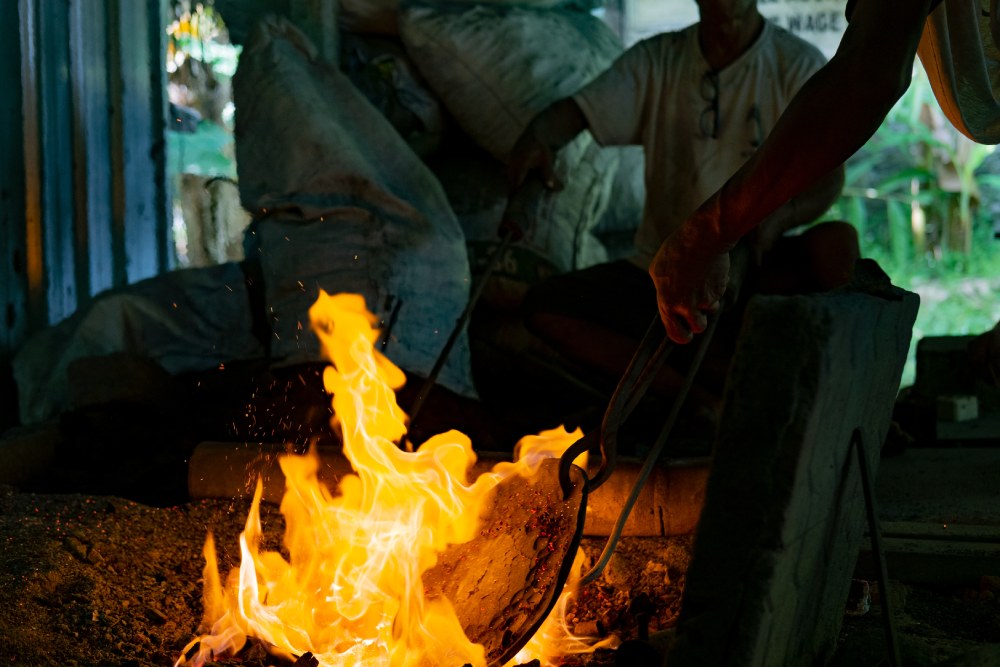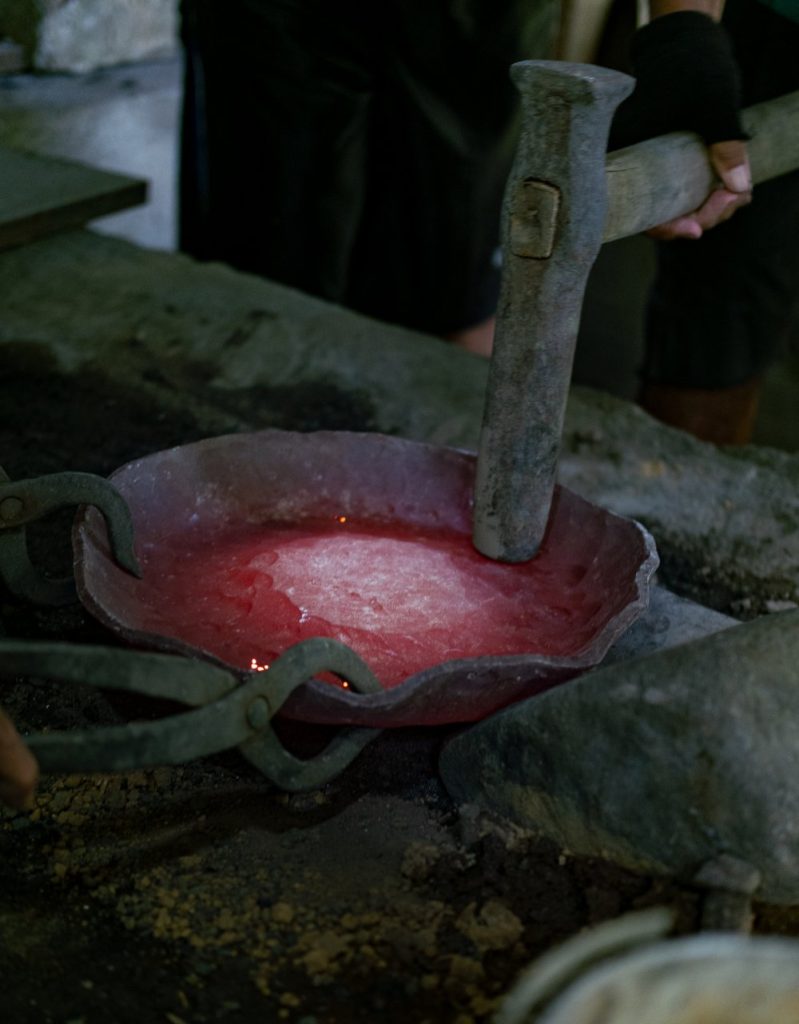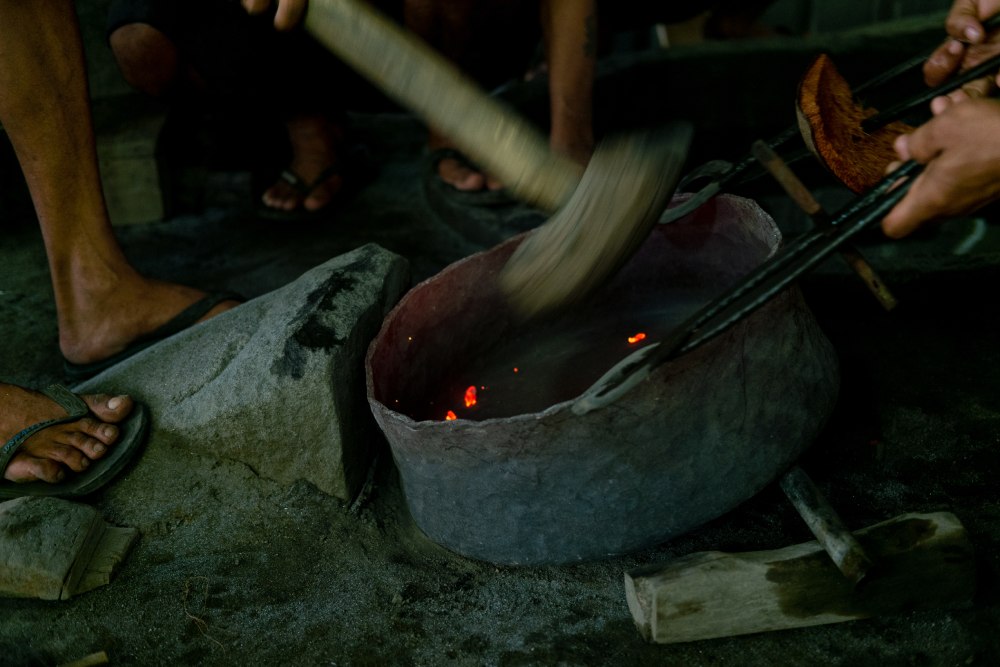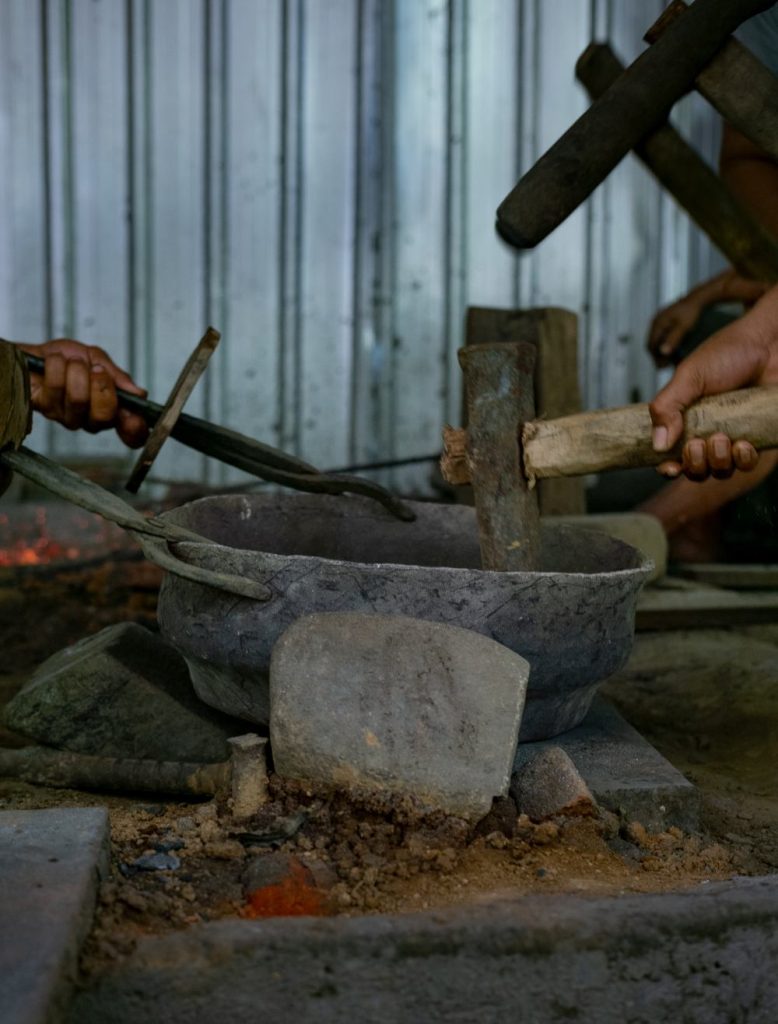
Clang! Dug! Ting!… Clang! Dug! Ting!… The sounds of metal pounding metal can be heard from a distance. Then a shout, some laughter, followed once again by the clamour of hammers. Clang! Dug! Ting! The cacophony of sounds repeat. These are the rhythms of the pande gong, the makers of Bali’s traditional gamelan.
Tihingan Village History

Though made across Java and Bali, it is the village of Tihingan, in the regency of Klungkung, that is renowned as the home of these musical craftsmen. Its location in Klungkung is of no coincidence: Bali’s most respected polity in history, the Gelgel Kingdom, a vassal state of the Javanese-Hindu Majapahit Empire, was situated within the regency. Through this connection, much of the Majapahit culture was spread through the royal court found in Gelgel, and later in Semarapura. Art, music and dance were supported and patronised by the royalty and nobles, and thus was always nearby. The most famous example of this is Kamasan village, where artists continue to uphold the traditional Kamasan-style (or wayang-style) painting that once decorated the palaces, like they still do for the ceiling panels of Kerta Gosa.
It is believed that Tihingan’s own history is also tied to that of the Gelgel Kingdom. A community of specialised craftsmen tasked to make the gongs, cymbals and metallaphones that constitute the majority of the traditional orchestra, known as gamelan. They are descendants of the pande clan, literally meaning smith. Though coming from the lowest Sudra caste (outside the recognised triwangsa of Brahmana, Ksatria and Wesya castes) their sought-after skills with metal were legendary — even considered magical — and granted them special status.



There are many types of pande, the most revered of which are the pande besi (metal smiths), who made weapons like the iconic Keris daggers, said to be imbued with powers and spirits. As for the villagers of Tihingan, they claim the title of pande gong.
Tihingan is a minuscule village. Its centre is found at a busy t-junction, marked by a soaring banyan tree and the Pura Dalem Temple. Here the vendors of the local market park themselves every morning, creating that charming local bustle that gives life to rural areas. Along the street front, signs for ‘pande gong’ and ’gong maker’ mark the entrance to homes, half-converted into workshops. The majority of the working population here, similar to Bali’s other specialised craft villages, focus on one vocation: gong making. A vocation that has survived since the 16th century.
The Making of Gamelan
There are two distinct expertise needed to make the instruments of the gamelan orchestra. One is the penguad or pengrajin, the metalworker who shapes the instrument; the other is the tukang laras, the sound expert, the tuner, responsible for ensuring each instrument (or individual key) hits the required note. There are many types of gamelan orchestra, the most common in Bali are the gamelan gong. Each of these orchestras features an ensemble of instruments from the gong, to the kumpur (small gong), bende (smaller gong), trompong (10-piece set), gangse (metallaphone), ceng-ceng (cymbals) — to a name a few of the metal-based ones.
The production process is rudimentary, relying on the ingrained skill and expertise of the worker. The pengrajin knows the shape and size required by eye and the tukang laras already has a trained ear for the notes. Is it perhaps the power of the pande blood?




The housing compound of I Made Soma Wandita is half-warehouse, half-workshop. Between the usual balés and pavilions, lines of gongs hang from wooden frames. In the corner, a small concrete smithy is where he works on smaller instruments, but more importantly it is where he smelts the metal plates used to make the gongs. Made Mangku, as he is called, makes his gongs out of bronze (perungu) or brass (kuningan), using a specific ratio of copper, zinc and lead. He creates plates of specific weights to match the required gong size: the medium-sized Kumpur gong, for example, would be around 9kg.
Despite having a smithy at home, Made Mangku does the heavy work elsewhere, in a large, open-spaced forge found beside bush and farmland. Under a tin roof and between make-shift walls a very specific setup has been prepared for gong-making.
Early in the morning, as the sunlight shines between the surrounding banana tree leaves, a group of men gather. A total of ten pengrajin are ready for a day of heavy work. Everyone seems to know their part and positions, working as two shifts of five. One man works the fire pit, another who handles the gong, and three carry the mallets and hammers.
The forging begins: a metal disc is thrown into a fire pit, with flames fed by coconut husks and charcoal. Fire, the element of Brahma, to whom the pande clan dedicate their offerings, is why their temples are swathed in red.
Using two long poles, the worker at the pit flips the metal disc in the fire like making pancakes. When it glows red, the metal is ready. The handler uses two tongs, carries the glowing disc to the prepared surface, a flat stone, and holds it there. The three men bring their hammers down upon it one after another — Clang! Dug! Ting! – hitting an area between the disc’s centre and rim (mid-radius). The handler twists the disc as they hammer down, flattening and expanding the metal. The disc is thrown back into fire, followed by a flurry of ash and cinder rushing into the air.

This process is repeated over and over, slowly shaping the metal into its desired size and form. From a disc of about 20cm in diameter, it expands to 55cm. Stones are placed beneath the disc at certain angles which, when hit, causes the walls of the gong to rise. It’s a fascinating process to watch, as the scorching metal bends and moulds with every strike. The gong, including its central ‘boss’ (or pencu), is shaped entirely through this process of heating, striking and twisting.
Different stations are used depending on the desired effect. The first station is used for the overall shape; another has the gong against an upright stone, where a soft mallet straightens the walls; and another horizontal stone is used to flatten the top surface. The metal hammers and wooden mallets also have their different uses, the former to shape and stretch, the latter to gently flatten or level. Run your hands along the inside of a gong and you will feel the grooves of each individual strike; the imprint of its makers. Together — in the spirit of gotong royong, Indonesia’s culture of group cooperation — a gong can be fashioned in around 3 to 4 hours.
Their tools harken back to another age, a rustic, artisanal crafting of materials using the tools around. Fire, stone, metal, wood and sweat. That being said, there are a few modern changes. Instead of the traditional blacksmith bellow (pump), an electric fan fuels the flames from beneath; an electric grinder is used to finish the boss, or shave the edges of the walls. Though dismissing the title of a pande, Made Mangku comes from a long generation of gong-makers, back to the glory days of Gelgel. Thus, he takes the ngeleras into his own hands.
As his friends clang beside him, laughing and chatting between shifts and strikes, Made Mangku tests and finishes the shaped gongs. He seems to know the tones by ear, unsurprising considering he has worked on them since 1997. There are a total of seven tones across the instruments of the gamelan (only five are commonly used), organised in a pentatonic scale. Though the sonics are important too: for a gong, achieving that deep, warm and elongated reverberation is key.



Luckily for this craft, demand remains high. Gamelans and gongs are essential to Balinese religious ceremonies as one of the panca gita (Five Sounds) required for rituals. So, banjar (village neighbourhoods), sanggar (art groups), pura (temples) and puri (palaces) will always need them, with more demand from music schools nationally and internationally.
Made Mangku’s son, I Putu Arya Sukma Darma, nicknamed Mame, is planning to continue his family legacy. He is studying traditional music at Institut Seni Indonesia (Indonesian Institute of the Arts) Denpasar, where he says his generation remain interested and involved. Competitions, showcases and innovations keep up the attraction, especially big shows like Pesta Kesenian Bali, the Bali Arts Festival, where troupes (sanggar) display their skill. No doubt the fact that the gamelan-making industry is relatively lucrative — one bende gong can cost around IDR 6 Million — is also a good incentive too. A proper value on artisanal products is what is required to ensure the continuation of craft traditions in Bali.
If the beating of the gongs and gamelan continue, so will the clamours of the Tihingan craftsmen.







